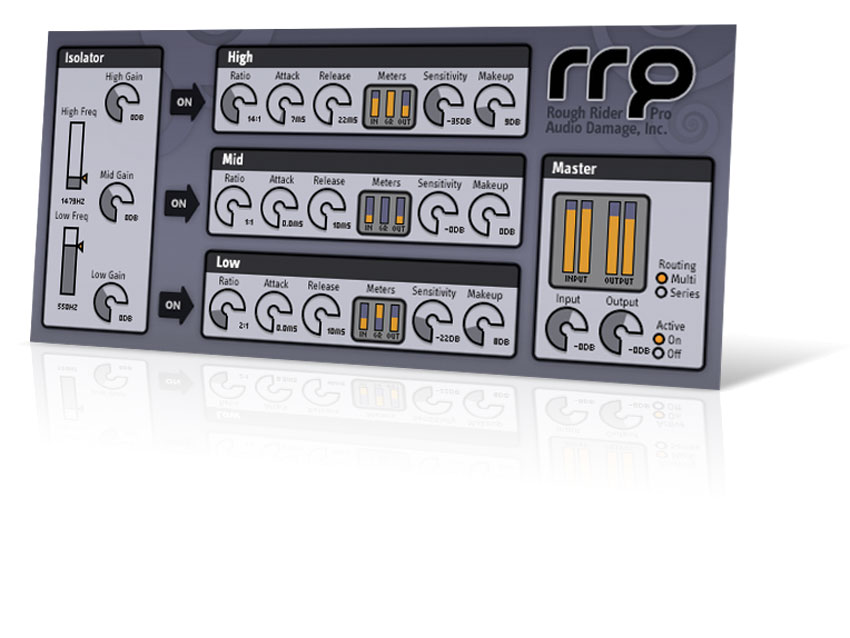MusicRadar Verdict
The sound and features are right on the money, but this isn't the smoothest operator available right now.
Pros
- +
Excellent sound. Versatile range of applications. Great presets. Innovative band-routing option.
Cons
- -
No A/B button. Hard to make out the display. No band-bypass switches.
MusicRadar's got your back
Looking back over the list of Audio Damage releases, pretty much all of them are groundbreaking plug-ins, or at least very original takes on older ideas. The only obvious exception to this was the awesome ADverb (originally called Reverence).
However, now AD has unleashed another 'traditional' effect - it's a multiband version of its acclaimed freeware compressor plug-in, Rough Rider. And, this new one has been given the Pro treatment.
Overview
At first glance, the familiar Audio Damage layout is evident, which is an encouraging start. Less impressive, though, are the very small interface and hard-to-read displays - this has become a worrying trend with Audio Damage.
It's easier to overlook with their more creative plug-ins, but if you can't tell whether something is -10dB or +10dB on a tiny dial, you're in trouble.
Each band has the expected compression parameters: Ratio, Attack, Release, Sensitivity (ie, threshold) and Makeup, as well as a metering section that shows the input, output and gain reduction levels.
Annoyingly, there's no bypass switch for each of the individual bands. Sure, you can set the knobs to zero to achieve the same result, but it's a fiddly way of doing things.
In use
Unlike many other multiband compressors, Rough Rider Pro offers three bands instead of four. However, we reckon this is ample for most uses and, indeed, most users. Without prior experience, additional options can simply translate into more ways to mess things up.
Want all the hottest music and gear news, reviews, deals, features and more, direct to your inbox? Sign up here.
So, for the best results, use the on/off buttons to isolate the band you want to dial in, then use the frequency sliders to select the range (the high and low cutoff points define the mids), Then, adjust the settings as you would any other compressor.
The only other thing you need to worry about is whether to run things in Multi or Series mode. The former splits the three bands, processes them separately and recombines them at the output stage, while the latter sends the signal to the top band, then the middle and finally the bottom. Both are useful, but we found Multi mode to be very clinical, while Series is more traditional and less surgical.
We tried out Rough Rider Pro on a variety of material, including finished tracks ready for mastering, and found the bass frequencies to be particularly punchy.
However, the mid- and top-end started to become a little digital when pushed hard, especially when compared to really high-end multiband processors.
A quick lick through the presets reveals a whole range of creative uses. You can squash signals pleasantly, or drive them to distortion. For such purposes, we can't really fault it.
Summary
Ultimately, a plug-in should be judged on a number of factors - its practicality, sound quality and ease of use being right up there. Naturally, there's no debating the usefulness of a multiband compressor, and Rough Rider Pro is particularly strong when it comes to creative applications, too.
As for the quality, this plug-in is capable of some serious results. It's impressive how much you can tighten up your bass, and it's even acceptable for mastering electronic material where transparency isn't essential.
But, Rough Rider Pro is not the most accessible of plug-ins. For example, there's no A/B button (very useful when applying dynamic effects) or auto-gain. Ultimately, the interface niggles and obstructions make using AD's latest a bit of a chore, which is a great shame.
So, while the sound is excellent for the price, and more than a match for higher priced competitors, we can't award Audio Damage its usual top marks. While it's worth getting hold of this plug-in, Rough Rider Pro is very much in need of a revision.
Listen to Rough Rider Pro doing its thing:
Dry loop
Instant dub bass
Nuclear option
Computer Music magazine is the world’s best selling publication dedicated solely to making great music with your Mac or PC computer. Each issue it brings its lucky readers the best in cutting-edge tutorials, need-to-know, expert software reviews and even all the tools you actually need to make great music today, courtesy of our legendary CM Plugin Suite.

